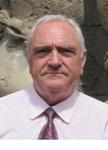Org. Synth. 2012, 89, 88-97
DOI: 10.15227/orgsyn.089.0088
Preparation of Enantioenriched Homoallylic Primary Amines
[]
Submitted by José C. González-Gómez, Francisco Foubelo, and Miguel Yus
1.
Checked by Rhia M. Martin and Jonathan A. Ellman.
1. Procedure
A. (4S,SS)-N-(tert-Butanesulfinyl)tridec-1-en-4-amine (4). An oven-dried 100-mL three-necked round-bottomed flask is charged with (SS)-N-tert-butanesulfinamide (2, 2.42 g, 20 mmol) and indium powder (2.90 g, 25 mmol) (Note 1). The flask is fitted with a condenser and equipped with a 0.8 × 2.5 cm magnetic stirring bar, a thermometer, a rubber septum, and a nitrogen inlet. After flushing with nitrogen, the flask is charged with THF (40 mL) by syringe, followed by decanal (1, 4.2 mL, 22 mmol) and Ti(OEt)4 (9.0 mL, 43 mmol), which are also added by syringe (Note 2). The slurry is stirred at 23-25 °C for 1 h, after which time (Note 3) allyl bromide (3, 2.65 mL, 30 mmol) (Note 4) is added via syringe over 5 min at 23-25 °C (Note 5). The mixture is heated to 60 °C for 5 h (Notes 6 and 7). After cooling to room temperature, the reaction mixture is carefully added to a mixture of ethyl acetate:brine (200 mL:50 mL) with stirring. The resulting white suspension is filtered through a short plug (5 cm × 2 cm) of Celite, which washed with ethyl acetate (about 600 mL total) until no more product is eluted. The organic layer is concentrated under reduced pressure and the resulting white suspension is diluted with hexanes:ethyl acetate (1:1) (50 mL). The suspension is filtered through a short plug (5 cm × 2 cm) of Celite, which is then washed with hexanes:ethyl acetate (1:1) (3 × 50 mL). The organic layer is concentrated under reduced pressure (40-80 mmHg) to afford crude protected amine 4 as a yellow oil (Note 8). The crude material is purified by flash column chromatography (33 × 5.5 cm column containing 320 g of silica gel) (Note 9). A mixture of hexanes:tert-butyl methyl ether (2:1) is used as the eluent, and fractions of 25 mL are collected using 30-mL vials (Notes 10 and 11). Fractions containing pure product are evaporated under reduced pressure to afford amine (4S,SS)-4 (3.21 g, 53%, >99:1 dr by 1H-NMR and HPLC) as a colorless oil (Notes 12, 13 and 14). Mixed fractions are purified by flash column chromatography (25 × 4.5 cm column containing 160 g of silica gel). A mixture of hexanes:tert-butyl methyl ether (2:1) is used as the eluent, and fractions of 20 mL are collected using 30 mL vials. Fractions containing pure product are evaporated under reduced pressure to afford additional amine (4S,SS)-4 (935 mg, 15%, >99:1 dr by 1H-NMR and HPLC) as a colorless oil to provide a 69% overall yield of diastereomerically pure product 4 (Note 15).
B. (4S)-1-Tridecen-4-amine (5). In a 125-mL round-bottomed flask, equipped with a 0.8 x 2.5 cm magnetic stirring bar, is placed a solution of compound (4S,SS)-4 (3.20 g, 21.4 mmol) in dry MeOH (100 mL) (Note 16), and the solution is cooled to 0-5 °C using an ice-water bath. To this cooled solution is added a 4M solution of HCl in dioxane (25 mL). After 10 min, the cooling bath is removed, and the reaction mixture is stirred for 2 h at room temperature. The resulting mixture is carefully concentrated to dryness under vacuum. The residue is dissolved in ethyl acetate (50 mL), cooled to 0-5 °C using an ice-water bath and treated with aqueous 6M NaOH (50 mL). After stirring for 10 min (Note 17), the phases are separated, and the aqueous layer is extracted with ethyl acetate (2 × 50 mL). The combined organic layers are successively washed with 2M NaOH (1 × 5 mL), H2O (1 × 5 mL) and brine (1 × 5 mL). The organic layer is dried over anhydrous sodium sulfate, filtered, and concentrated under reduced pressure (40-80 mBar). The residue is carefully dried under vacuum (ca 0.7 mmHg) until constant weight to afford pure amine 5 (1.94 g, 93%) as a yellow oil (Notes 18 and 19).
2. Notes
1.
The checkers received (
SS)-
N-
tert-butanesulfinamide (
2) as a gift from AllyChem (>99%
ee by chiral HPLC on a Chiracel AS column, 90:10 hexanes/
i-PrOH, 1mL/min, λ = 222 nm). Indium powder (>99%) was purchased from Alfa Aesar. The submitters received (
SS)-
N-
tert-butanesulfinamide (
2) as a gift from Medalchemy. (
SS)-
N-
tert-butanesulfinamide (
2) is also available from many commercial suppliers.
2.
THF (HPLC grade, 99.9% purity) was purchased from Scharlau and used as received. A new bottle of decanal (
1) (96 %, Alfa Aesar) was used without further purification. Titanium(IV) tetraethoxide (33-35% TiO
2) was purchased from Across Organics.
3.
At this point, a sample was removed and submitted to
1H NMR analysis, confirming full conversion of
2 into the corresponding
N-tert-butanesulfinyl imine
6 intermediate.
1H NMR (300 MHz, CDCl
3) d: 0.88 (t,
J = 6.6 Hz, 3 H), 1.20 (s, 9 H), 1.23-1.39 (m, 12 H), 1.56-1.69 (m, 2 H), 2.52 (td,
J = 7.4, 4.8 Hz, 2 H), 8.07 (t,
J = 4.8 Hz, 1 H),
4.
Allyl bromide (3), 99% was purchased from Alfa Aesar and filtered through a short plug (0.7 × 2.5 cm) of alumina (activity 1).
5.
Caution: Approximately 5 min after the addition of allyl bromide (
3), upon beginning to heat the reaction mixture, the reaction became very exothermic with the internal temperature rapidly rising to ~65 ºC. It was therefore necessary to remove the heating bath for about 5 min.
6.
It is important to control the temperature in the reaction mixture. At 40 ºC the reaction is significantly slower.
7.
The reaction progress can be monitored by TLC analysis on Merck silica gel 60 F
254 plates and visualization with phosphomolybdic acid (5% in EtOH). Using hexanes:ethyl acetate (3:1) as eluent, compound
2 has an R
f = 0,
N-tert-butanesulfinyl imine
6 has an R
f = 0.77, diastereomer (4
R,
SS)-
4 (minor) has an R
f = 0.32, diastereomer (4
R,
SS)-
4 (major) has an R
f = 0.26, and the homoallyl alcohol by-product
7 has an R
f = 0.85.
8.
The crude oil contained a 10:1 mixture of (4
R,
SS)-
4 : (4
S,
SS)-
4 with the diastereomeric purity determined by
1H-NMR
pdf analysis based on the NH signals: major diastereomer 3.22 (d,
J = 6.1 Hz); minor diastereomer 3.07 (d,
J = 5.9 Hz) (see attached NMR).
9.
Silica gel 60, 230-400 mesh (Sorbent Technologies) was used.
10.
The column fractions were checked by TLC analysis on Merck silica gel 60 F
254 plates with hexanes:ethyl acetate (3:1) as eluent and visualization with phosphomolybdic acid. R
f values are given in
Note 7.
11.
The minor diastereomer (4
R,
SS)-
4 elutes before the major one. Concentration of fractions 58-94 furnished 2.18 g (36%) of a 78:22 mixture of (4
R,
SS)-
4/(4
S,
SS)-
4 (according to
1H NMR). Concentration of fractions 95-168 furnished 3.21 g (53%) of (4
S,
SS)-
4 (>99:1 according to
1H NMR).
12.
The physical properties of (4
S,
Ss)-
4 are as follows:
1H NMR
pdf (400 MHz, CDCl
3) δ: 0.88 (t,
J = 6.9 Hz, 3 H), 1.20 (s, 9 H), 1.22-1.39 (m, 14 H), 1.43-1.53 (m, 2 H), 2.30 (dt,
J = 13.9, 6.9 Hz, 1 H), 2.41 (dt,
J = 12.8, 6.4 Hz, 1 H), 3.19 (d,
J = 6.0 Hz, 1 H), 3.25-3.36 (m, 1 H), 5.13 (d,
J = 1.7 Hz, 1 H), 5.17 (d,
J = 2.0 Hz, 1 H), 5.70-5.85 (m, 1 H);
13C NMR
pdf (101 MHz, CDCl
3) δ: 14.2, 22.7, 25.5, 29.4, 29.56, 29.61, 29.63, 32.0, 35.0, 40.5, 54.9, 55.8, 118.9, 134.3; IR (neat, cm
-1) 3208 (br), 2923, 2854, 1640, 1457, 1389, 1363, 1176, 1051. Anal. calcd. for C
17H
35NOS: C, 67.72; H, 11.70; N, 4.65. Found: C, 67.39; H, 11.58; N, 4.69. The submitters report the specific rotation of a 97:3 mixture of (4
S,
SS)-
4/(4
R,
SS)-
4 as [α]
20D +45.8 (c 2.6, CH
2Cl
2).
13.
The diastereomeric purity was determined by
1H NMR analysis (see
Note 8).
14.
The submitters further confirmed the diastereomeric purity of compound
4 by converting it to the corresponding benzamide according to the following procedure. To a solution of
4 (0.1 mmol) in MeOH (1 mL) was added 4M of HCl in dioxane (0.3 mL), and the solution was stirred 1.5 h at room temperature. After cooling to 0 °C, 2M NaOH (5 mL) was added, followed by benzoyl chloride (32 µL, 0.25 mmol), and the resulting mixture was stirred over 2 h at room temperature (23 °C). After aqueous workup, a sample [GC-MS (EI): 301 (M
+, 1%), 260 ([M-C
3H
5]
+, 39%); 105 ([M-Bz]
+, 100%); 77 (18%)] was submitted to chiral HPLC analysis. The chromatography was performed on a JASCO 200-series apparatus equipped with a Chiralcel OD-H column 25 cm × 0.46 cm (isocratic elution with 10%
i-PrOH in
n-hexane, 1.0 mL/min, UV detection at 254 nm); t
R = 6.3 min (
R), t
R = 7.7 min (
S).
15.
Concentration of fractions 48-72 furnished 977 mg (16%) of a 66:34 mixture of (4
R,
SS)-
4/(4
S,
SS)-
4. Concentration of fractions 73-108 furnished 935 mg (15%) of (4
S,
SS)-
4 (>99:1 dr).
16.
MeOH (99.8%) was purchased from J. T. Baker and distilled from magnesium.
17.
At this point the pH of aqueous phase was >12. Importantly, at pH 8-9 the corresponding ammonium hydrochloride is isolated using the same procedure.
18.
The submitters report that according to GC-MS (EI): 136 ([M]
+, 0.6%); 79 ([M-C
4H
9]
+, 5%); 57 ([C
4H
9]
+, 23%); the main impurity is likely
t-BuSO
2Me (t
R = 4.9 min), which is volatile. After keeping under house vacuum (0.7-3.5 mmHg) until constant weight, only the expected compound
5 was observed by GC (t
R = 10.5 min). GC analyses were obtained on an Agilent 5973N equipped with an HP-5 column (30 m × 0.25 mm, ID × 0.25 µm) and an EI (70 EV) detector. The temperature program: hold at 60 °C for 3 min, ramp from 60 °C to 270 °C at 15 °C/min, hold at 270 °C for 10 min.
19.
The physical properties of
5 are as follows:
1H NMR
pdf (500 MHz, CDCl
3) δ: 0.86 (t,
J = 6.7 Hz, 3 H), 1.20 (s, 2 H), 1.44-1.21 (m, 17 H), 1.88-2.01 (m, 1 H), 2.13-2.27 (m, 1 H), 2.75 (s, 1 H), 5.05 (s, 1 H), 5.08 (d,
J = 8.3 Hz, 1 H), 5.69-5.83 (m, 1 H);
13C NMR
pdf (126 MHz, CDCl
3) δ: 14.4, 23.0, 26.6, 29.6, 29.86, 29.92, 30.0, 32.2, 38.0, 42.9, 50.9, 77.1, 77.3, 77.6, 117.4, 136.3; IR (neat, cm
-1) 3354 (br), 3076, 2956, 2922, 2853, 1640, 1466, 1439, 1378, 1354, 1130. The submitters report the specific rotation as [α]
20D -6.2 (c 1.1, CH
2Cl
2)
Handling and Disposal of Hazardous Chemicals
The procedures in this article are intended for use only by persons with prior training in experimental organic chemistry. All hazardous materials should be handled using the standard procedures for work with chemicals described in references such as "Prudent Practices in the Laboratory" (The National Academies Press, Washington, D.C., 2011 www.nap.edu). All chemical waste should be disposed of in accordance with local regulations. For general guidelines for the management of chemical waste, see Chapter 8 of Prudent Practices.
These procedures must be conducted at one's own risk. Organic Syntheses, Inc., its Editors, and its Board of Directors do not warrant or guarantee the safety of individuals using these procedures and hereby disclaim any liability for any injuries or damages claimed to have resulted from or related in any way to the procedures herein.
3. Discussion
Addition of allylmetals to the C=N bond of enantiomerically pure
N-
tert-butanesulfinyl imines are among the most widely used approaches for the asymmetric synthesis of homoallylic amine derivatives.
2 Allylmagnesium,
3 allylzinc,
4 and allylindium
5 species have been used; however, the synthesis and isolation of the corresponding
N-sulfinyl imines has been required. In contrast, we describe in this procedure a method based on
in situ formation of
N-
tert-butanesulfinyl imines and subsequent indium-mediated allylation.
6 Thus, enantioenriched homoallylamine derivatives are directly obtained from commercially available aldehydes, allyl bromides, and chiral
tert-butanesulfinamide. It was found that two equivalents of Ti(OEt)
4 were required to promote the reaction efficiently,
7 and good results for a range of aldehydes were obtained when allyl bromide (
3) was added after
in situ pre-formation of the
N-sulfinyl imine for 1 hour at room temperature. Notably, the reaction works better when aliphatic aldehydes are used, but aromatic and α,β-unsaturated aldehydes also afford the corresponding homoallylic amine derivative in good yields and stereoselectivities (Table 1).
5 It is worth noting that although
Table 1. Other homoallylic amine derivatives prepared using this protocol
enantioenriched aromatic homoallylic amines currently can be prepared using a large number of protocols, methods to prepare the aliphatic derivatives with good selectivity are scarce. Since conversion of
tert-butanesulfinamide to the
N-sulfinyl imine with Ti(OEt)
4 is not complete within 1 hour for all of the aldehydes explored, it is possible that indium(III) salts formed
in situ accelerate both the formation of the
N-sulfinyl imine and its allylation.
8 Importantly, despite the presence of Lewis acid (indium and titanium salts) and Lewis base species (water/ethanol), we observed the same sense and degree of stereoselectivity
9 that we have previously observed for the indium-mediated allylation of pre-formed
N-sulfinyl imines.
4bAdditionally, the reaction was investigated using 3-phenylpropanal and other allyl bromides, such as methallyl bromide, prenyl bromide and racemic cyclohexenyl bromide, each of which proceeded with very good chemo- and stereoselectivities (Table 2).
Table 2. Reaction with other allylic bromides
Moreover, it is worth mentioning that the synthetic utility of homoallylamine derivative (4
S,
SS)-
4 has already been illustrated in a short synthesis of (+)-isosolenopsin,
10 while (4
R,
RS)-
4 was used to prepare (+)-preussin and several analogs.
11 On the other hand, the
N-Cbz protected amine
5 has been recently used in a four-step synthesis of the alkaloid (+)-241D (Figure 1).
12Figure 1.
Appendix
Chemical Abstracts Nomenclature (Collective Index Number);
(Registry Number)
(Ss)-N-tert-Butanesulfinamide: (S)-(−)-2-Methyl-2-propanesulfinamide; (343338-28-3)
Indium; (7440-74-6)
Decanal: Decyl aldehyde; (112-31-2)
Titanium(IV) ethoxide: Tetraethyl titanate; (3087-36-3)
Allyl bromide: 3-Bromo-1-propene; (106-95-6)
(rac)-1-Tridecen-4-amine; (893402-88-5)
 |
Miguel Yus was born in Zaragoza (Spain) in 1947, and received his BSc (1969), MSc (1971) and PhD (1973) degrees from the University of Zaragoza. After spending two years as a postdoctoral fellow at the Max Planck Institut für Kohlenforschung in Mülheim a.d. Ruhr he returned to Spain to the University of Oviedo where he became associate professor in 1977, being promoted to full professor in 1987 at the same university. In 1988 he moved to a chair in Organic Chemistry at the University of Alicante where he is currently the head of the newly created Organic Synthesis Institute (ISO). His current research interest is focused on the preparation of very reactive functionalized organometallic compounds and their use in synthetic organic chemistry, arene-catalyzed activation of different metals, preparation of new metal-based catalysts, including metallic nanoparticles for homogeneous and heterogeneous selective reactions, and asymmetric catalysis.
|
 |
José Carlos González Gómez was born in 1971 and grew up in Havana, Cuba. He obtained his B.S. (1994) and M.S (1998) in chemistry at Havana University. In 1999 he moved to the University of Santiago de Compostela (Spain), where he got his Ph.D degree (2003) working on the synthesis of bioactive psoralen derivatives. After a postdoctoral stay (2005-2007) at the ETH in Zurich, he started as "Juan de la Cierva" researcher at the University of Alicante, where he became Assistant Professor in 2008. Dr. González-Gómez has co-authored about 30 papers and his research interest is currently focused on the development and application of stereoselective reactions for the synthesis of bioactive compounds, mainly involving chiral sulfinimines.
|
 |
Francisco Foubelo was born in 1961 and grew up in Eastern Asturias. He studied chemistry at the University of Oviedo from which he received B.S. (1984), M.S. (1986), and Ph.D. (1989) degrees. After a postdoctoral stay (1989-1991) as a Fulbright fellow at Princeton University, he moved to the University of Alicante where he became Associate Professor in 1995 and Full Professor in 2002. Dr. Foubelo has co-authored more than 100 papers, and his current research interests are focused on the development of new synthetic methodologies involving chiral sulfinimines and on metal-promoted functionalization of alkenes and alkynes.
|
 |
Rhia M. Martin received her B.S. degree at Georgetown University in Washington, DC in 2007. She then joined Professor Jonathan A. Ellman's and Professor Robert G. Bergman's research groups at University of California, Berkeley, where she is pursuing her Ph. D. degree. Her graduate research focuses on the development of methodologies to access nitrogenous heterocycles through C-H functionalization.
|
Copyright © 1921-, Organic Syntheses, Inc. All Rights Reserved